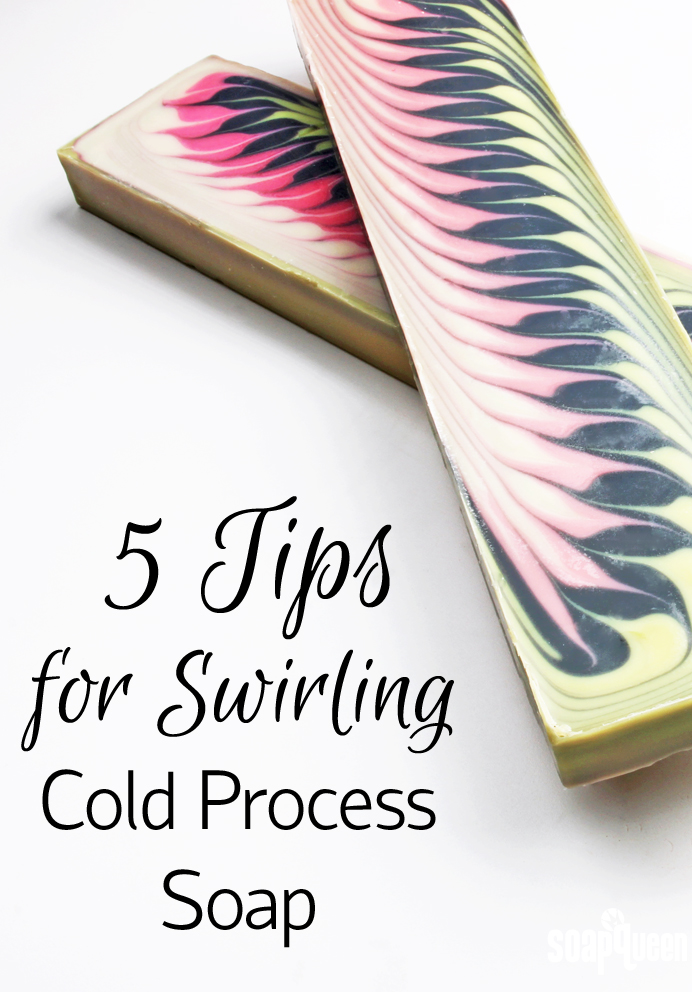
The ability to manipulate the texture of cold process soap allows for a wide variety of techniques. For example, thick textured soap mimics the look of cupcake frosting in the Sparkling Champagne Soap Cupcakes. On the flip side, fluid soap batter is used to create complex swirls in the Clover & Aloe Spin Swirl Soap. Swirling cold process soap takes a little practice, but is well worth it. There is something about swirling soap that is satisfying and relaxing. And the final product is beautiful!
From spin swirls and drop swirls to hanger swirls and in-the-pot swirls, there are many different swirling techniques. While each technique involves a slightly different process, there are steps you can take to ensure your soap is successful. Below are five tips for creating gorgeous swirls in cold process soap.
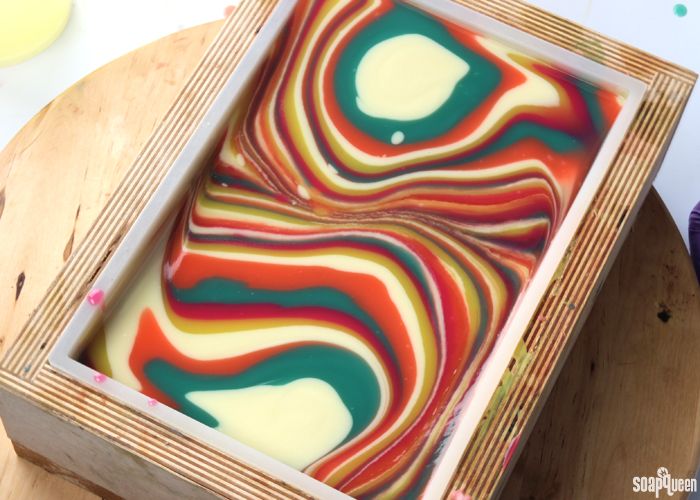
Thoroughly Prep Ingredients and Soaping Area
When making a swirled soap, timing is key. The longer soap batter sits, the thicker it will become. Once you begin the saponifcation process, be ready to move quickly. Have your colorants mixed, fragrance weighed and all your necessary tools nearby. Thorough prepping helps the process run smoothly. There is nothing worse than running around looking for another whisk when your soap is starting to thicken up! See my tips for setting up your soaping area in this post.

Formulate Your Recipe Correctly
Cold process swirls are made with thin or medium trace soap batter. Trace is the point in the soapmaking process when oils and lye water have emulsified and will not separate. Once the soap has reached thin trace, it will continue to thicken. To learn more about trace, check out the All About the Trace blog post.
The key to soap batter that stays thin for long enough to create swirls is using plenty of “slow-moving” oils. Slow-moving oils refer to oils that do not accelerate trace. In general, slow-moving oils are liquid at room temperature. Oils that are firm at room temperature will accelerate trace in soap. Examples of oils and butters that accelerate trace are palm oil, coconut oil, all butters, palm kernel flakes, beeswax, and castor oil. Click here to learn more about common soapmaking oils and butters.
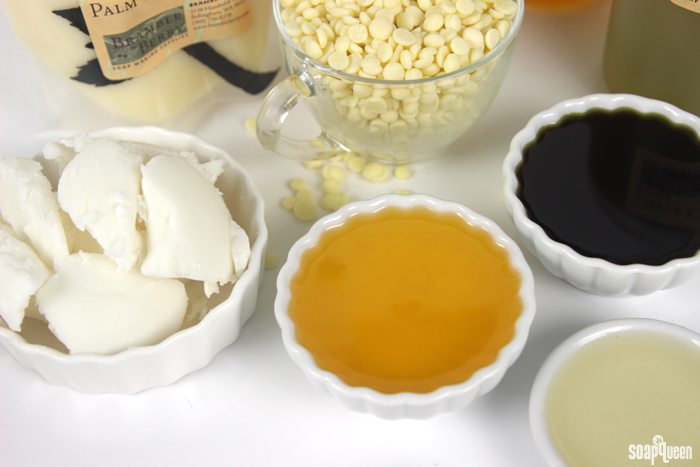 Choosing the right soapmaking oils is the first step to a successful swirled design.
Choosing the right soapmaking oils is the first step to a successful swirled design.
Some of the most popular slow moving oils are pure olive oil, canola oil, sweet almond oil, sunflower oil, avocado oil, apricot kernel oil, rice bran oil and chia oil. Keep in mind some slow-moving oils are slower than others. For example, I would categorize rice bran oil as slow moving, but it does accelerate trace more than pure olive oil. From my experience the slowest-moving oils are canola oil, pure olive oil and sweet almond oil. To create a recipe that gives you lots of time to swirl, I recommend formulating your recipe with about 60% slow moving oils. To learn more about formulating your own cold process recipes, click here.
Looking for some recipes that are suitable for swirls? Check out the tutorials below!
Clover & Aloe Spin Swirl Cold Process Soap
Psychedelic Spin Swirl Cold Process Soap
Butterfly Swirl Cold Process Soap
Charcoal & Cedar Beer Cold Process Soap
Fall Sherbet Cold Process Soap
Galaxy Clyde Slide Cold Process Soap
Silky Berry Cold Process Soap
Soap at Slightly Cooler Temperatures
The “average” soaping temperature is around 110-130° F. Every soaper has their temperature preference, which may vary from recipe to recipe. When soaping at higher temperatures (130° F or above), thick trace will be reached more quickly than when soaping with cooler temperatures (100° or below). Many soapers prefer to soap at room temperature when making a complex swirled soap. Even adjusting your temperatures by just 10 degrees can make a huge difference in the texture of your soap batter.
Use Your Stick Blender Sparingly
Stick blenders are the unsung hero of cold process soapmaking. They emulsify oils and lye solution within minutes, or even seconds. But, stick blenders emulsify oils and lye so quickly that it can be easy to over-emulsify to a trace unsuited for swirls. Once you over-blend your soap, there is no way to get that lovely thin to medium trace back.
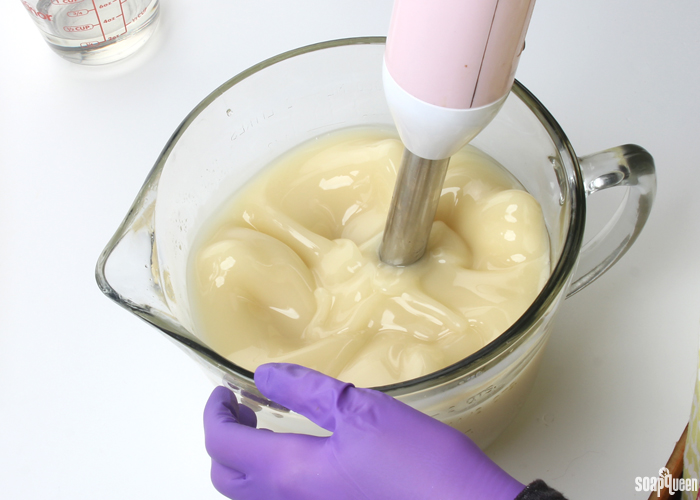 Stick blending your batter for too long can lead to a thick trace which inhibits the ability to swirl.
Stick blending your batter for too long can lead to a thick trace which inhibits the ability to swirl.
The key to maintaining a thin trace until you’re ready to swirl is to take turns pulsing the stick blender and using it to stir the batter. Pulse the stick blender in short bursts. And remember, you can always stick blend more later! Once you reach a thin trace, I prefer to use a whisk to stir in my colorants. I also whisk in my fragrance oil last. This gives me the most time to work with my batter before it starts to thicken.
Use the Correct Fragrance/Essential Oil
Fragrance oils can do interesting things to cold process soap batter. After all, fragrance oils can be made up of hundreds of essential oils and aroma chemicals (though most are made of a handful). Adding them in the middle of the sopp making process can produce varying results. From separation to ricing, you can see some of the negative effects of misbehaving fragrance oil in the Soap Behaving Badly post. Luckily, Bramble Berry tests all fragrance oils thoroughly to make sure they behave well in cold process soap.
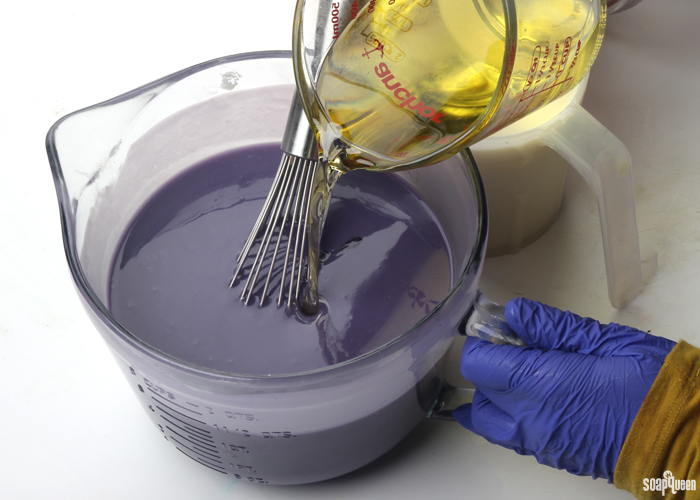 If creating a swirled soap design, use a fragrance oil that does not accelerate trace. In the Electric Lemonade Column Pour Tutorial, I used Electric Lemonade Cocktail Fragrance Oil, which behaves well in cold process soap.
If creating a swirled soap design, use a fragrance oil that does not accelerate trace. In the Electric Lemonade Column Pour Tutorial, I used Electric Lemonade Cocktail Fragrance Oil, which behaves well in cold process soap.
Acceleration is a mild form of “misbehaving” fragrance oil. A fragrance that causes acceleration will thicken the soap batter once mixed in. If the design requires a thick trace, an accelerating fragrance oil is great. But if you’re aiming for a swirled soap, avoid fragrance oils that accelerate trace. Not sure how the fragrance oil behaves? Bramble Berry includes fragrance oil testing notes on each fragrance oil product page.
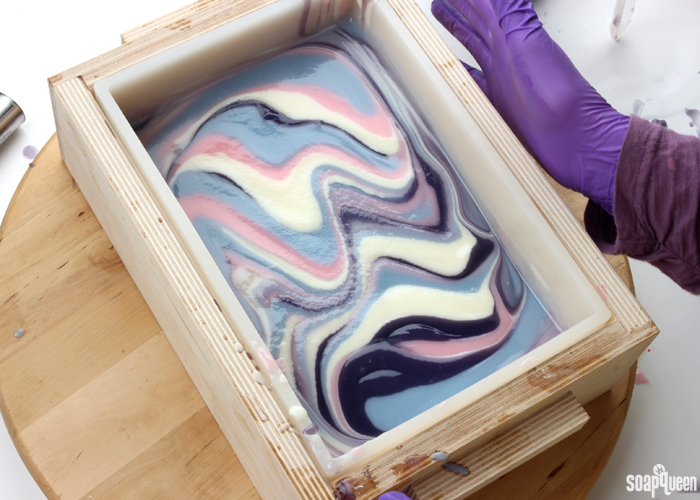
My last swirling tip, and maybe the most important? Don’t give up! Even after soaping for over 20 years, some of my swirl techniques don’t go quite as planned. A great example of this is the spin swirl technique (above). This technique requires an extremely thin trace and I have a few “failed” batches of spin swirls soap under my belt. But even these “fails” still look beautiful and made wonderful soap. With every batch of soap you learn and get better. =)
Do you have any tips or tricks for creating swirled cold process soap? Do you have a favorite swirl technique? I’d love to hear them below; there is always room for improvement.




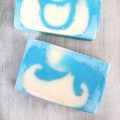
Your spin swirls look amazing. I just completed my 4th and yet another failed batch! So frustrating!!!! I can’t seem to get it finished before it thickens up and then the surface is oddly textured and hideous. I thought it would look better if I planed the surface but nope! Ugh!!!!!! Depressing.
Spin swirling is a more advanced technique. When we first tried it, we went through at least three failed batches because the soap got too thick. Keep at it, once you get the right consistency it gets a lot easier. You may try adding more liquid oils and double checking the notes on your fragrance to make sure it doesn’t accelerate.
This post has some good tips as well: https://www.youtube.com/watch?v=PJvKaU22lzs&t=93s
Just love this website! I have a question – just wanted to be sure that this formula will give me great moisturizing, and a little harder soap. I wanted more bubbles so I added castor oil. I still want to be sure I don’t get quick acceleration, as I want to be able to do those wonderful swirls.
Here’s my formula:
Castor oil 2.9%
Coconut oil (92 degree) 27.8%
Olive oil 34.8%
Palm oil 18.6%
Unrefined Shea butter 15.9%.
What do you think? Will this work?
thanks so much for your time.
Yes, that should work well. The coconut, palm, and shea will help create a firmer bar and the castor will help add bubbles. Butters can accelerate trace just a bit, so you can reduce the shea to around 10% and increase the olive oil just to be safe. A small test batch would be helpful to see how it performs before creating a larger batch. 🙂
-Kelsey with Bramble Berry
thank you so much – will try that!
How did that formula go Andrea?
Do you find that when formulating for a swirls recipe (i.e., 60% liquid oils, 40% hard), that you lose some of the desirable qualities of the final product? I generally make my soap with your recommended trio of coconut/olive/palm with castor and then a little of something else, maybe palm kernel flakes for hardness and bubbles or shea/cocoa/mango butter, etc. (I also LOVE silk tussah fiber and always add the recommended amount of sodium lactate.) This seems to make a very bubbly, lathery, silky bar. I noticed that when formulating with swirls in mind, some of those desirable qualities like bubbles and creaminess are reduced. Do you find your swirly soap to be any less luxurious compared to a regular recipe? I haven’t seen a discussion about this.
Recipes formulated for swirls can definitely affect the way the bars feel. We usually add a lot of liquid oils, which can create softer and slightly less cleansing bars. However, castor oil definitely helps. When used at 2-5%, it helps add cleansing and lathering properties to the recipe: https://www.brambleberry.com/Castor-Oil-P3195.aspx
You can also add other ingredients to make it creamy – one of my favorites is milk. It makes the bars feel really nice and silky.
Learn more about working with milk here: http://www.soapqueen.com/bath-and-body-tutorials/tips-and-tricks/how-to-add-lye-to-milk-for-cold-process-soap/
-Kelsey with Bramble Berry
Thank you for this article. I’ve only made soap to felt so far so looks did not matter and a thick trace was fine. I’m now allergic to wool and am trying my first “pretty” soap. It will be a hunting soap that is naturally coloured with no added scent. I’m using ground dandelion leaves black walnut husks, and calendula petals as my 3 colours. I am thinking of 50% Olive oil pomace, 35% coconut oil, and 15% sunflower oil. Do you have any insights on its possible success or demise?
Hi Sam!
I’d be happy to give some suggestions :). Your percentages of oils look fine, although you may considering lowering the amount of coconut oil slightly. Some soapers prefer to stay under 30% and find that more 35% of coconut oil or more can be a little drying. But that’s a personal preference! 🙂
Using natural colorants in soap can be a little tricky. Most will eventually fade with time, and some will result in very little color at all. Calendula petals are a great addition to soap, and are one of the few botanicals that stay bright and don’t go brown and fade over time. I have never worked with dandelion leaves before, but my guess is they will eventually turn brown in your soap. This may also be true for black walnut husks. You may want to make a very small test batch to see how these colorants react in your soap over time.
If you’re looking for more natural colorant options, you may find the blog posts below helpful!
Natural Colorant Testing and Inspiration: https://www.soapqueen.com/bath-and-body-tutorials/tips-and-tricks/natural-colorant-testing-inspiration/
Spotlight Natural Colorants: https://www.soapqueen.com/bramble-berry-news/sunday-night-spotlight-natural-colorants/
Guest Post: Testing Natural Colorants in Cold Process: https://www.soapqueen.com/bath-and-body-tutorials/cold-process-soap/guest-post-testing-natural-colorants-cold-process/
I hope this helps Sam! 🙂
-Amanda with Bramble Berry
Hi, just wondering if there’s a book on slow moving EO & FO for CP soap.
Thx Bub
Hi Bub!
We don’t have a book, but we do have a list of fragrances that perform well in soap! I’ll paste those below. You can also learn how each fragrance performs in the description on BrambleBerry.com. 🙂
Blackberry Sage, Wasabi, LoveSpell, Apricot Freesia, Pineapple Cilantro, Energy, White, Tea & Ginger, Oatmeal Milk and Honey, Dark Rich Chocolate, Yuzu Cybilla, Lavender 40/42, Black Amber & Lavender, Lime essentail oil and fragrance oil, Kumquat, Rise & Shine, Pink Grapefruit, Sensuous Sandalwood, Red Apple, Champagne, Fresh Snow, Fresh Bamboo and Fresh Mango.
You can find all those fragrances here: https://www.brambleberry.com/Fragrance-Oils-C161.aspx
And essential oils here: https://www.brambleberry.com/Essential-Oils-C157.aspx
-Kelsey with Bramble Berry
I love the little mold. Is it sold at Brambleberry?
It sure is! That’s our 9 Bar Unfinished Birchwood Mold. It works really nicely for soapmaking. 🙂
9 Bar Unfinished Birchwood Mold: https://www.brambleberry.com/9-Bar-Unfinished-Birchwood-Mold-P5169.aspx
Silicone Liner for 9 Bar Mold: https://www.brambleberry.com/Silicone-Liner-for-9-Bar-Mold-P5812.aspx
-Kelsey with Bramble Berry
great information here. I am an experienced HP soaper, but have only recently begun CP. My biggest two issues by far are accelerated trace. Now I know it’s probably because I love adding tallow and a little castor oil to my mixes…I may never get a super thin batter, but will keep trying different ratios. I have a separate problem though, which is sort of off topic, but has to do with soda ash. Every batch I have made so far starts off looking great, but ends up after my 48 hours cure time with soda ash. I have been insulating well. Do you think adding seran wrap and a heating pad will help ? I have read mixed reviews. Also, I just discovered that my alcohol spritzer was only 70%…do you think that made the difference? I know…lots of questions, but until I solve the ash problem, I am wasting my swirls!!
Hi, Kristen. I used to have issues with soda ash and over insulating CP soap can make it get too hot and other issues like glycerin rivers will happen. Been there, done that!! If it occurs on a smooth top, you can “wash” it if with a damp wash rag. However, I learned from here (where I learned most of my good tips) that 91% or higher rubbing alcohol is very effective at preventing soda ash. I spray it on after the soap has just become slightly firm to the touch and I never have issues with soda ash. I hope this helps!
p.s. CP is my preferred soap, but I also love HP soap and make a fair amount of it, too and soda ash is not an issue!
thank you for the great tips…yes, finding out that my alcohol spritz has only been 70% alcohol was a big lightbulb for me!
Hi Kirsten!
Soda ash can definitely be pesky. The great news is you can get rid of it. You can wash it with a damp rag like Eric suggests, wipe it with an old nylon or steam it. 🙂
There are also several tricks to prevent it! We’ve found that 99% isopropyl alcohol works best for preventing soda ash. You can spritz the top several times with 99% alcohol every 15 minutes for the first hour. That helps create a barrier that protects the soap. Insulating the soap can help as well. You can pop top on the soap and cover it with a towel or blanket. You can also put it on a heating pad, just make sure to watch the soap so it doesn’t get too hot. Read more about insulating soap here: http://www.soapqueen.com/bath-and-body-tutorials/tips-and-tricks/when-to-insulate-handmade-soap/
It can also help to decrease your superfat slightly, and pour the soap when it’s a bit thicker. Soaping a little warmer can help too (around 120F). Get more tips in the explaining and preventing soda ash post: http://www.soapqueen.com/bath-and-body-tutorials/tips-and-tricks/explaining-and-preventing-soda-ash/
-Kelsey with Bramble Berry
thanks Kelsey, I will definitely change to the 99% alcohol, and will re-read the warmer temp article. I have been using a sponge or rag to “wash” my CP soaps…I haven’t tossed them, just was disappointed because the swirls and things just didn’t show up as beautifully as I see online pictures. I am going to persist!! Will read more, get the right alcohol and am very appreciative of this site and the help! thx.
You’re very welcome! Let us know how your next batch turns out. 🙂
-Kelsey with Bramble Berry
Such great information thanks! And I agree, even if you have a “fail” it’s still gorgeous soap! Only you know that it didn’t come out as planned 🙂 That photo with the purple soap under the fragrance/essential oil section – that looks like a truck load of fragrance!
You’re welcome Michael, glad you like the post! Also, that picture felt like a truckload of fragrance! It was a 12 pound batch of soap so we added 10 ounces of Electric Lemonade Cocoktail Fragrance Oil. It was weird seeing that much fragrance added at one time!
-Kelsey with Bramble Berry
Electric Lemonade Cocktail Fragrance Oil: https://www.soapqueen.com/bath-and-body-tutorials/cold-process-soap/electric-lemonade-column-pour-tutorial/
My vegan recipe is notoriously fast moving, but it seems to have mostly slow moving oils…any thoughts on what is making it do that? It’s a good recipe, but I’d love to reformulate so I don’t have to plan for speed…I just don’t know what to swap out. Thanks!
Olive oil – 38%
Coconut Oil – 25%
Cocoa butter – 13%
Rice Bran Oil – 13%
Castor oil – 7%
Canola oil – 5%
Just my opinion, but you have a lot of cocoa butter and castor there. If it were me and I wanted a slower moving recipe I would switch some of them. I’d do:
Olive 38%
Coconut oil 25%
Rice Bran oil 13%
Canola oil 13% (or 10%)
Cocoa Butter 7% (or 10%)
Castor oil 5%.
Thank you, Martina. I was trying to create a harder bar with the amount of cocoa butter I use…I don’t want to use palm. But I’ll consider reducing the cocoa butter. I’m looking to cut costs anyway. 🙂
Hi Katie!
That’s a great recipe! It looks nice and moisturizing.
I think the cocoa butter may be what’s making the soap move faster. If you’re soaping at lower temperatures, the cocoa butter can start to thicken before everything is emulsified. I would recommend soaping around 115-120F. That will ensure the cocoa butter stays melted and gives you a bit more time to work! You can also decrease the amount slightly and add more slow-moving oils like canola or olive. 🙂
-Kelsey with Bramble Berry
Thanks, Kelsey. I wondered if that might be it, but I use the same amount of cocoa butter in my lard recipe with no issues. Nice, slow trace on that one. But I will try soaping warmer. 🙂
You’re welcome Katie! Let me know how it goes. 🙂
-Kelsey with Bramble Berry
Wait, I just realized your numbers come to 101% not 100%. So I’d do this then
Olive 38%
Coconut 25%
Rice Bran 12%
Canola 13% (or 10%)
Cocoa Butter 7% (or 10%)
Castor 5%
have you tried to use your lye co, like cold from the refrigerator? i do that and works fine
*cold
You can use cold lye for soapmaking! That actually keeps the water cooler when you’re adding the lye so it’s ready to use more quickly. The only thing to watch out for when using room temperature lye/oils is false trace. If the lye is too cold, it can solidify hard oils in the batch and cause the soap to thicken quickly! Read more about false trace here: https://www.soapqueen.com/bath-and-body-tutorials/tips-and-tricks/spot-prevent-false-trace/
-Kelsey with Bramble Berry
A quick note first. People often use a different name on online forums and James is my first name, but I go by Eric so James is now Eric: no need to hide behind a screen name here. Now, I have a tried and true recipe that I almost never change and it has a high percent of coconut oil so it traces quickly and most of my recipes use a thick trace. However, for a thin trace, my recipe still works well if I let the lye and oils cool down to room temp. This past Saturday, I made a gorgeous faux funnel pour which required some time to work with a thin batter.
Great article!
Eric, formerly known as James
That’s awesome Eric! Temperatures definitely play a role in how quickly the soap thickens. 🙂
-Kelsey with Bramble Berry
Another tip I found helpful was to NOT discount water.
It may add a few extra curing days to your batch but will allow you a long enough time to play
Absolutely Jin, that is a great tip! Water discounted soap does accelerate more quickly, so using the full amount of water is helpful for swirls. 🙂
-Kelsey with Bramble Berry
Water Discounting Cold Process Soap: How and Why: http://www.soapqueen.com/bath-and-body-tutorials/tips-and-tricks/water-discounting-cold-process-soap-how-why/
Hi,
It is my experience that not only a FO can accelerate trace but also some colorants. Especially yellow oxide ends up thicker than my other colors. When using YO for a swirl, I mix my batter to a very thin trace, add my colorant and mix some more if needed.
With kind regards,
Annemieke
That is such a good tip Annemieke! Clays can accelerate trace, and I’ve noticed certain oxides can as well. Making test batches with new colorants is always helpful. 🙂
-Kelsey with Bramble Berry
I have noticed that with both yellow oxide and brown oxide too. I have found it helps to mix them with more oil than other colorants need, so I mix 1 teaspoon of oxide with 2 tablespoons of oil. I also whisk them in whenever possible, and that seems to help too!
Oh that’s a great tip LuAnn! The extra oil can help keep them more fluid and not as thick. 🙂
-Kelsey with Bramble Berry
After reading this, I think I will start whisking in my colorants as well! A good ol’ drop swirl is still one of my very favorites 🙂
I love drop swirling too! The pattern is so interesting. Thanks for reading Jenny. 🙂
-Kelsey with Bramble Berry